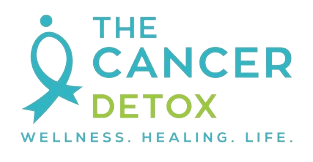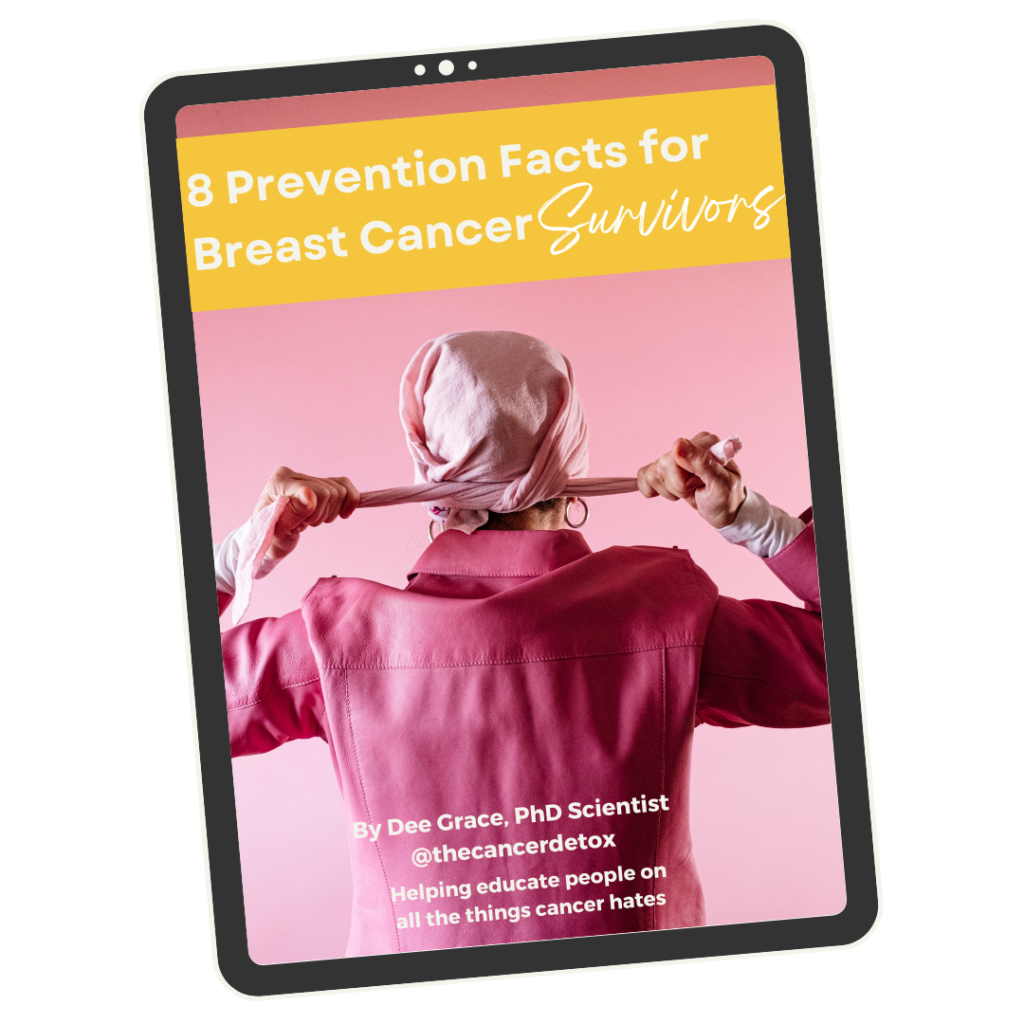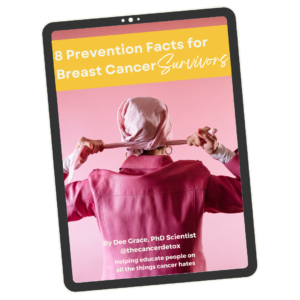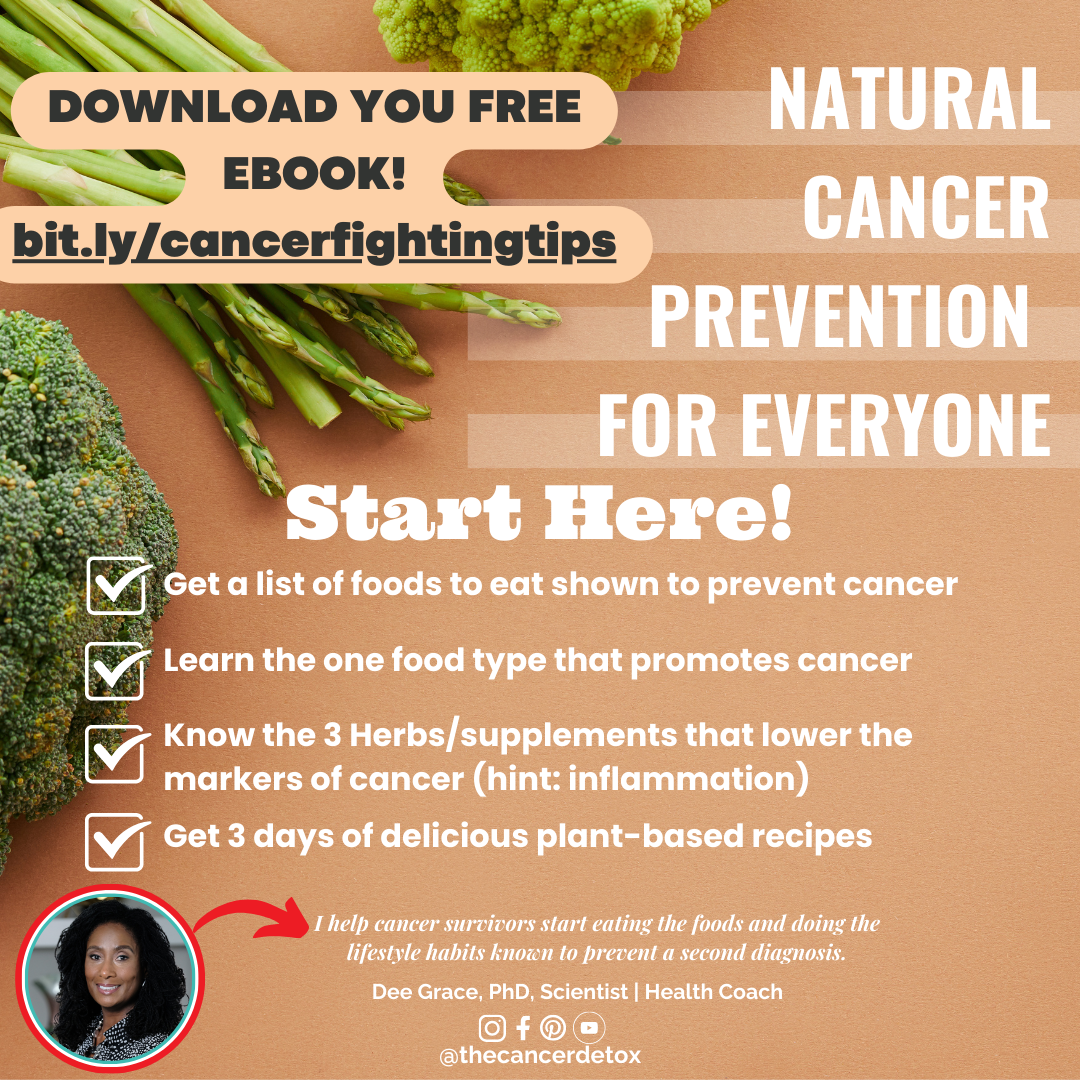Lower Your Breast Cancer Risk by Up to 25% with a High Fiber Diet (Plus Recipes)
A cancer prevention diet should start with fiber. A breast cancer diet should consist of the same. In this article we will review how fiber helps prevent a new or recurring breast cancer, and include high-fiber smoothie recipes…
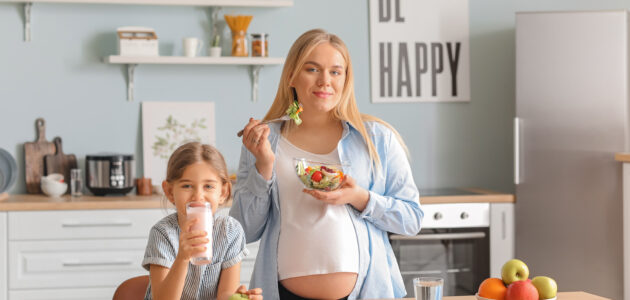
High fiber diet and breast cancer (post updated May 2023)
In this article, you will learn:
- How BLUEBERRIES are a breast cancer fighting food! Eating 2 servings a week lowered risk of a breast cancer recurrence by 25%.Read below to see how long breast cancer survivors needed to eat them, and get the blueberry smoothie recipe (an important ingredient in cancer fighting smoothies)
- A high-fiber diet lowers the risk of breast cancer recurrence by 12%. Adolescent girls that eat a high fiber diet also lower their risk of a new breast cancer diagnosis later in life
- Click here to download our FREE eBook “8 Prevention Facts for Breast Cancer Survivors” which includes 8 facts on how a breast cancer diet and lifestyle lowers the risk of a recurrence. It also includes 3-days of healthy, plant-based recipes.
INTRODUCTION
A high-fiber diet begins with eating natural, minimally processed, plant-based foods such as legumes, vegetables, and fruits. Sure fiber supplements can help, however you will be missing out on hundreds of other nutrients found in whole, natural foods. Things like flavanols and other phytonutrients from natural foods increase the benefits of the high fiber found in these foods.
FIBER FIGHTS BREAST CANCER
In our last post, we discussed the health benefits of fiber in a cancer prevention diet and discussed how it reduces the risk of certain cancers by up to 60%. Studies are now showing that a high fiber diet may lower the risk of breast cancer too! While the exact mechanisms by which fiber intake may reduce the risk of breast cancer are not yet fully understood, fiber appears to work to lower breast cancer risk in the following ways:
- FIBER REGULATES HORMONE LEVELS: Fiber may help regulate levels of estrogen and other hormones in the body. High levels of estrogen have been associated with an increased risk of breast cancer, particularly in postmenopausal women.
- FIBER PROMOTES HEALTHY GUT BACTERIA: Fiber is known to promote the growth of healthy gut bacteria, which may have a positive impact on overall health, including reducing inflammation and potentially reducing the risk of certain types of cancer.
- FIBER LOWERS INSULIN RESISTANCE: High-fiber diets have been associated with a lower risk of insulin resistance, which has been linked to an increased risk of breast cancer.
It’s important to note that the relationship between fiber intake and breast cancer prevention is complex and may be influenced by a variety of factors, including overall diet, physical activity levels, and other lifestyle factors. Therefore, while increasing fiber intake may be a useful component of an overall healthy lifestyle, it should not be relied upon as the sole means of breast cancer prevention.
BREAST CANCER DIET FOR SURVIVORS
In 2023, it is estimated that over 297,000 women will be diagnosed with breast cancer resulting in 29,000 deaths [1]. American women have a 1 in 8 (13%) chance of developing the disease. The healthcare disparities are also high in breast cancer patients, as African-American women have a higher chance of being diagnosed at a younger age, and they (as well as Native American and Hispanic women) are more likely to be diagnosed with invasive breast cancer (which is harder to treat) [1].
Breast cancer survivors are always eager to learn about breast cancer fighting foods that lower their risk of a recurrence. Fruits, vegetables, whole grains, and legumes are always a great place to start because of their high fiber content. Eating vegetables will provide 2 – 3 grams of fiber, brown rice 1.5 grams, and beans provide a whopping 16 grams of fiber!
READ MORE ARTICLES ON BREAST CANCER SURVIVORSHIP that focus on a breast cancer diet and preventing a breast cancer recurrence . These articles highlight what the latest science says on foods that help lower the risk of a second breast cancer diagnosis.
Breast Cancer Recurrence: Blueberries and Vegetables Lower Risk of a Second Diagnosis
-
- CRUCIFEROUS VEGETABLES: Breast Cancer Survivors Lower Risk of Recurrence by 13%: A recent review study that analyzed data from many different medical studies (i.e., meta analysis) found that breast cancer survivors who ate 1 serving of cruciferous vegetables every day had a 13% lower chance of dying from any disease [2]
- LEAFY GREEN VEGETABLES: Those who ate 2 servings of green leafy vegetables had a 20% lower chance of dying from any disease [2]
- BLUEBERRIES: Eating 2 servings of blueberries a week lowered risk of breast cancer death by 25% and death from any cause by 17% [2]. The women ate blueberries for 12 months straight after their breast cancer diagnosis. There were over 1,000 women who were included in this study analysis, a sizeable number for which to have some confidence in these results
- HIGH FIBER DIET: The study by Farvid MS [2] is also backed up by another meta analysis that found that in breast cancer survivors that ate a high fiber diet during the 12 months after their diagnosis had a significant 12% decrease in death due to the disease (this from 1,092 study participants). Though the evidence is limited due to there being just three published studies on this topic, the outcomes suggest that fiber intake may benefit breast cancer survivors [3]
New Breast Cancer Diagnosis: Fiber Lowers Risk of a New Diagnosis in Adult Women
-
- These results were published in the Nurse’s Health Study (88,000 women) and Nurse’s Health Study II (over 93,000 women), which followed the lifestyle habits of women since 1980 and 1991, respectively
- The study found that women who ate 5.5 or more servings of fruits and vegetables daily had an 11% lower risk of breast cancer compared to women who ate 2.5 servings or less
- Eating more than 4 servings a week of both orange/yellow and cruciferous vegetables had a 17% reduction in breast cancer [4]
-
- A recent study found that for every 10-gram increase in fiber intake, breast cancer risk decreased by 5%
- This dose response (i.e., as the dose increases, the outcome is affected) remained even when more than 30 grams of fiber in a day was consumed [5]
Fiber Lowers Risk of Breast Cancer in Adolescent Teen Girls
-
- To protect your teenage daughters and granddaughters, provide them with a high-fiber diet.
- The latest studies show that fiber reduces the risk of pre-menopausal breast cancer by 24%
- These same studies show that the lifetime risk of breast cancer drops by 16% for teens and young women eating a high-fiber diet [6]
RECIPES FOR A BREAST CANCER DIET
Click here to download our FREE eBook “8 Prevention Facts for Breast Cancer Survivors” which includes 8 facts on how a breast cancer diet and lifestyle lowers the risk of a recurrence. It also includes 3-days of healthy, plant-based recipes.
Ready for delicious recipes made with cancer fighting foods? Well you’re in luck, because below are some of The Cancer Detox’s rated the best by our clients.
1. BLUEBERRY DELIGHT SMOOTHIE
This is one or our top rated cancer fighting smoothies. It contains two important cancer fighting foods: cruciferous vegetables and blueberries.
INGREDIENTS
- Add 1 cup of Napa cabbage to blender first (a cruciferous vegetable and a leafy green that does not change the smoothie color to green!)
- 1 cup of fresh or frozen blueberries (organic is best)
- 1/2 Apple (seeds removed)
- Small wedge of lemon (include rind, wash well!), about tablespoon size
- 2 sprigs of mint (optional)
- 2 teaspoons of coconut yogurt (unsweetened)
- Sweeten with agave syrup or stevia powder
- 1 cup of water
- Blend and enjoy
Nutrition Facts: Calories 208.6 calories; Fat 5 g; Carbs 24.7 g; Protein 2.7 g; Sodium 7.8 mg; Fiber 3.8 g; Saturated fat 5 g
1. SEA ME SALAD
When it comes to food that fight cancer, you won’t go wrong with salads. Big ones at that. If your salad has leafy green vegetables and cruciferous vegetables, you’ll have two powerful cancer fighting foods in one meal.
INGREDIENTS
- 2 cups Spring Lettuce Mix
- 1/2 cup Red Cabbage, thinly sliced
- 1/2 cup Cherry Tomatoes, sliced in half
- 1/2 cup Carrot Sticks, julienned
- 1/2 cup cooked garbanzo beans
- 1/4 cup of Raisins (for added sweetness)
- 1 – 3 Seaweed Sheets, crumble over salad (adds a bit of salt)
- 1/4 cup almond slices or pumpkin seeds
- 1/2 cup Fennel Bulb, thinly sliced (optional)
- 3 – 4 cooked Beet Slices (thinly sliced)
Nutrition Facts: Calories 357.5 kcal; Fat 16.4 g (Monosaturated – 1.04 g, Polyunsaturated 1.61 g, Saturated 0.5 g); Carbs 73.51 g; Protein 13.33 g; Fiber 16.4 g; Sugar 37.4 g
Here’s To Your Best Health!
Dee Grace, PhD

Hi! I am Dee Grace Ph.D., Scientist and Health Coach at The Cancer Detox. My career in cancer research has allowed me to work with doctors to find new treatments for this disease. I brought my scientific knowledge to The Cancer Detox to help patients get better care from their doctors during their cancer treatment process, so the focus is on improving their survival outcomes and reducing the financial burden caused by cancer treatment. If you are a cancer patient Schedule a complimentary call (click here) with me now to discuss how to reduce your financial burden and get questions every patient needs to ask their doctor (schedule soon! spots fill up quickly because I am busy researching and helping clients).
I also help people adopt a “prevention first!” mindset. Why? Because, so you don’t have to experience the long-lasting financial setbacks a cancer diagnosis causes. My new book “Cancer Prevention: Diet and Lifestyle Factors that Reduce Your Risk” focuses on cancer fighting foods and how to adopt a cancer fighting diet. Sign up for my early bird NEW BOOK list and get 50% of the book price plus my newest guide on the health benefits of Spirulina for weight loss, heart health, skin care, and eye health.

